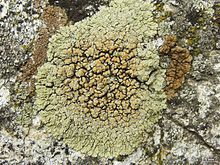Lecanora muralis
| Lecanora muralis | |
|---|---|
 |
|
| Scientific classification | |
| Kingdom: | Fungi |
| Division: | Ascomycota |
| Class: | Lecanoromycetes |
| Order: | Lecanorales |
| Genus: | Lecanora |
| Species: | L. muralis |
| Binomial name | |
|
Lecanora muralis (Schreb.) Rabenh. (1845) |
|
| Synonyms | |
|
|
Lecanora muralis is a waxy looking, pale yellowish green crustose lichen that usually grows in rosettes radiating from a center (placoidiod) filled with disc-like yellowish-tan fruiting bodies (apothecia). It grows all over the world. It is extremely variable in its characteristics as a single taxon, and may represent a complex of species. The fruiting body parts have rims of tissue similar to that of the main nonfruiting body (thallus), which is called being lecanorine. It is paler and greener than L. mellea, and more yellow than L. sierrae. In California, it may be the most common member of the Lecanora genus found growing on rocks (saxicolous).
It grows on rock including basalt, pumice, rhyolite, granite, sandstone, and limestone. Sometimes it can be found growing on bark. It may be tightly or loosely attached to the substrate.
It grows all over the world including in Europe, Asia, North America, South America, Africa, Macaronesia, Oceania, and Australasia. In California, it may be the most common member of the Lecanora genus found growing on rocks (saxicolous). In the Sonoran Desert it is found from southern California to both north and south Baja California, and through Arizona to Sonora, Mexico, at elevation ranges from 20 to 2,800 metres (66 to 9,186 ft).
...
Wikipedia
